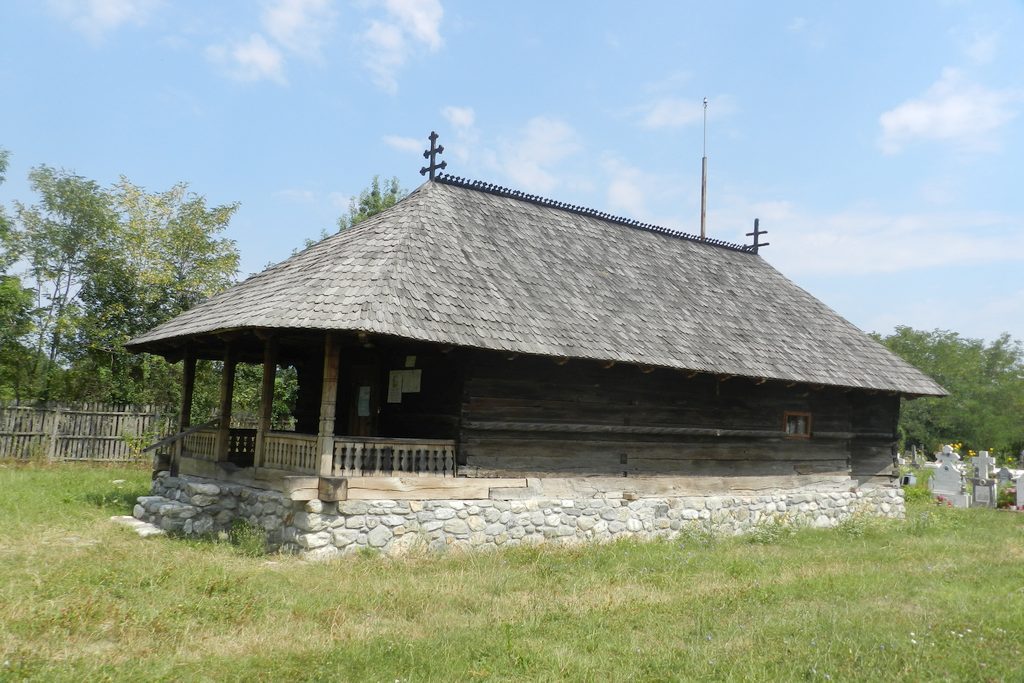

The wooden church, dedicated to St. Paraskevi in Momaiu dates from the eighteenth century, being registred in the list of the historical monuments of the county Olt.
The place of worship was moved from the place where he was originally raised as the position became almost inaccessible to the villagers. It was built on concrete foundation, belongs to the second planimetric typology, with symmetrical unhooked apse of the altar, with narrow porch, on four poles, like the peasant house. The walls are made of thick oak beams, carved and finished on top in the shape of horse heads. The joining of beams is performed in the “double loop” sistem. The motif of the waist, twisted rope shaped is present on the outer face of the walls, the same motif making also the oval frame of the entrance door. Interior painting is missing, its place being taken by icons.
Born in Epivat on the shore of Sea Marmara near Constantinople, the former capital of the Byzantine Empire, Saint Paraskevi has acquired, since childhood the faith in Christ. At age 10, while she was in a church, she heard the words of the Holy Gospel: “Sell your possessions, give it to the poor and follow Me” (Matthew 19, 21). It was the moment which decided definitively the route that the Pious would follow: that of faith in Christ and the sacrifice for those in need. After she turned 20, she left the parental home in Epivat, heading toward the holy places in Jerusalem, that she wanted fervently to see. She started this long pilgrimage passing first through Constantinople, where she prayed at the the relics of the saints in the city.
After five years, Saint Parascheva came to Jerusalem, deciding to stay for the rest of her life in the places where Jesus and the Apostles lived. So, after she prayed at the Holy Places, she went to the Jordanian desert, to a convent, where John the Baptist and Pious Mary of Egypt lived, leading a hard life full of struggles.
At age 25 she left the monastery from the Jordanian desert, heading back home. Therefore the young Paraskevi went back to Constantinople, where, once she arrived, she prayed in the great church of Saint Sophia and to the miraculous icon of the Virgin Mary from Blachernae, thinking which way to turn on.
At age 27, Saint Paraskevi died and her body was buried near the sea. Her holy relics were discovered much later by a monk and were put at a place of honor after the Pious revealed herself in a dream of a certain Gheorghe Kallicrateia. That is why the fragrant and incorrupt body of Saint Paraskevi was moved to the church of the Holy Apostles of Kallicrateia, where it is said to have stood for 200 years. From Kallicrateia, Paraskevi relics were moved in 1235 to Tarnovo (Bulgaria today), where they stayed for 160 years. From here they were taken to Belgrade, where they stayed until 1521 from where they returned to Constantinople for another 120 years. In 1641, the relics of the Pious set off towards Moldova in a long journey, after Prince Vasile Lupu received the relics as a gift from the Ecumenical Patriarchate of Constantinople. Thus, on June 13, 1641 St. Paraskevi relics were placed in the church “Three Hierarchs” where Moldavians have honored them until 1889 when were moved to the Metropolitan Cathedral, where they rests today.
